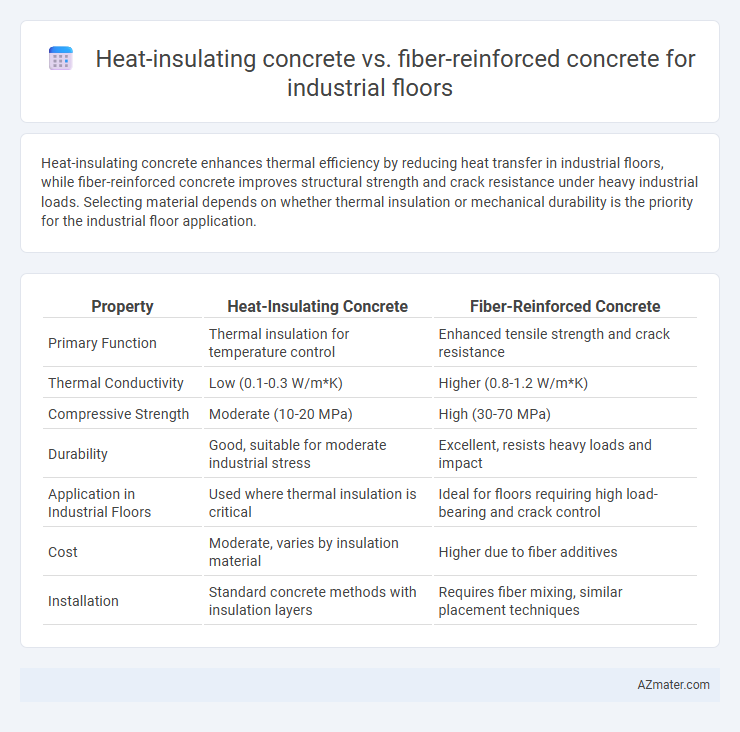Heat-insulating concrete enhances thermal efficiency by reducing heat transfer in industrial floors, while fiber-reinforced concrete improves structural strength and crack resistance under heavy industrial loads. Selecting material depends on whether thermal insulation or mechanical durability is the priority for the industrial floor application.
Table of Comparison
| Property | Heat-Insulating Concrete | Fiber-Reinforced Concrete |
|---|---|---|
| Primary Function | Thermal insulation for temperature control | Enhanced tensile strength and crack resistance |
| Thermal Conductivity | Low (0.1-0.3 W/m*K) | Higher (0.8-1.2 W/m*K) |
| Compressive Strength | Moderate (10-20 MPa) | High (30-70 MPa) |
| Durability | Good, suitable for moderate industrial stress | Excellent, resists heavy loads and impact |
| Application in Industrial Floors | Used where thermal insulation is critical | Ideal for floors requiring high load-bearing and crack control |
| Cost | Moderate, varies by insulation material | Higher due to fiber additives |
| Installation | Standard concrete methods with insulation layers | Requires fiber mixing, similar placement techniques |
Introduction to Industrial Flooring Solutions
Heat-insulating concrete offers superior thermal resistance, reducing energy costs in industrial buildings by maintaining consistent floor temperatures. Fiber-reinforced concrete enhances structural integrity and durability, minimizing cracking and extending the lifespan under heavy industrial loads. Selecting the appropriate flooring solution depends on balancing thermal performance with mechanical strength requirements for optimal industrial floor functionality.
Overview of Heat-Insulating Concrete
Heat-insulating concrete for industrial floors offers superior thermal resistance, reducing energy consumption and maintaining temperature stability in manufacturing environments. It incorporates lightweight insulating aggregates such as expanded perlite or vermiculite to minimize heat transfer while maintaining adequate compressive strength for heavy-duty industrial use. This type of concrete improves overall energy efficiency and provides enhanced comfort without compromising durability or load-bearing capacity.
Key Features of Fiber-Reinforced Concrete
Fiber-reinforced concrete for industrial floors offers enhanced tensile strength and crack resistance due to the embedded synthetic or steel fibers, ensuring durability under heavy loads and mechanical stress. Its improved impact resistance and reduced shrinkage make it ideal for environments with frequent traffic and harsh conditions, providing long-term structural integrity. The material also enables thinner slab designs without compromising performance, optimizing both material use and installation efficiency.
Thermal Performance Comparison
Heat-insulating concrete offers superior thermal resistance due to embedded insulating materials, effectively reducing heat transfer and maintaining stable floor temperatures in industrial settings. Fiber-reinforced concrete, while primarily enhancing mechanical strength and crack resistance, provides limited improvement in thermal insulation compared to specialized insulating concrete mixes. For industrial floors prioritizing energy efficiency and temperature control, heat-insulating concrete demonstrates significantly better thermal performance than fiber-reinforced concrete.
Mechanical Strength and Durability
Heat-insulating concrete offers moderate mechanical strength with enhanced thermal resistance, making it ideal for temperature-sensitive industrial floors but less suitable for heavy load applications. Fiber-reinforced concrete significantly improves mechanical strength and durability by distributing stress and reducing crack propagation, ensuring long-lasting performance under heavy traffic and dynamic loads. Choosing between these materials depends on balancing thermal insulation needs with the required load-bearing capacity and floor lifespan in industrial environments.
Crack Resistance and Structural Integrity
Heat-insulating concrete enhances industrial floor performance by reducing thermal stress, which mitigates crack formation and improves overall durability in fluctuating temperature environments. Fiber-reinforced concrete significantly increases crack resistance through the distribution of tensile stresses across microfibers, maintaining structural integrity under heavy loads and dynamic forces. Combining these materials can optimize industrial floors by balancing thermal insulation and superior crack resistance, ensuring long-term stability and reduced maintenance.
Installation Process and Cost Considerations
Heat-insulating concrete requires specialized layering techniques and the incorporation of insulating aggregates, resulting in longer installation times and higher labor costs compared to fiber-reinforced concrete. Fiber-reinforced concrete offers a simpler pouring and finishing process, reducing installation time and overall expenses while improving durability and crack resistance for industrial floors. Cost considerations favor fiber-reinforced concrete for budget-conscious projects, whereas heat-insulating concrete provides energy-saving benefits that may offset its initial higher investment.
Maintenance Requirements and Lifecycle
Heat-insulating concrete for industrial floors offers enhanced thermal performance, reducing energy costs and minimizing thermal stress, which lowers maintenance frequency and extends lifecycle durability. Fiber-reinforced concrete provides superior tensile strength and crack resistance, leading to fewer repairs and longer service intervals under heavy mechanical loads. Both materials improve floor lifespan, but fiber-reinforced concrete typically demands less maintenance in high-impact environments while heat-insulating concrete excels in temperature-sensitive applications.
Environmental Impact and Sustainability
Heat-insulating concrete reduces energy consumption in industrial floors by enhancing thermal efficiency, lowering greenhouse gas emissions associated with heating and cooling. Fiber-reinforced concrete increases the lifespan and durability of industrial floors, minimizing resource use and waste through reduced maintenance and repairs. Both materials contribute to sustainability, with heat-insulating concrete supporting energy conservation and fiber-reinforced concrete promoting structural longevity and material efficiency.
Choosing the Right Concrete for Industrial Floors
Heat-insulating concrete offers superior thermal resistance, reducing energy costs in temperature-sensitive industrial environments, while fiber-reinforced concrete enhances structural durability and crack resistance under heavy mechanical loads. Selecting the right concrete involves assessing operational temperature demands, load-bearing requirements, and maintenance schedules to optimize floor performance and lifespan. For industrial floors subjected to thermal stresses and heavy machinery, a hybrid mix combining heat insulation properties with fiber reinforcement can provide balanced strength and energy efficiency.

Infographic: Heat-insulating concrete vs Fiber-reinforced concrete for Industrial floor
 azmater.com
azmater.com